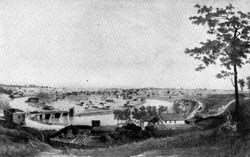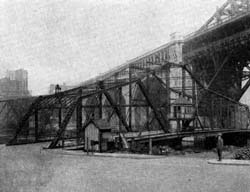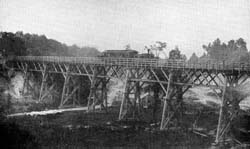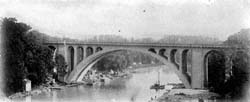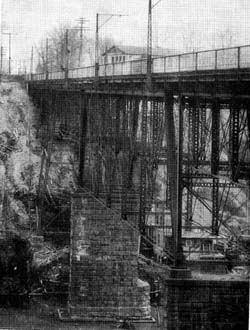|
Bridges of Cleveland and Cuyahoga County, 1918 THE EARLY BRIDGES OF CLEVELAND By Elroy McKendree Avery By Elroy McKendree Avery The Cuyahoga valley has a history that is prehistoric. The foundation upon which Cleveland rests is recent geology reckons eras, but very ancient as written history counts backward her periods of the doings of men. For many years, students have been gathering and interpreting data. Some of their conclusions are that some of the later geologic epochs of our world history were marked by movements of the earth’s crust, grossly comparable to the progressive wrinkling of a pickled orange, and by concomitant or consequent changes of climate. The first of these, the glacial epoch, was characterized by an upward movement of the earth-crust in high latitudes until that part of the continent was lifted several thousand feet above its present height. On the plateaus thus elevated, snow fell and was easily compacted into ice. Under pressure, ice is plastic and acts much as pitch would act under similar circumstances. Thus the ice-mass of the glacial period was analogous to a river, the current being supplied by the snowfall in far northern regions. This immense PRESENT COLUMBUS STREET BRIDGE
THE CUYAHOGA VALLEY FROM SCRANTON HEIGHTS ABOUT 1860 mass of ice, thousands of feet in thickness, moved slowly southward, sweeping away vast forests, tearing off the tops and sides of ledges, mixing the debris with its own mass, and grinding much of it together to form boulder-clay. Gravel, sand, clay, and boulders picked up or torn off by the ice were thus carried southward and there left as the ice-sheet melted. The granite hard-head boulders that are not uncommon on the surface of this sandstone region of northern Ohio were thus imported form Canada and laid down at our doors. In this way, the drainage of the glaciated region, of which Cuyahoga County is a part, was so changed that the country resembles, on a large scale, a checked and worm-eaten plank which a carpenter has filled with putty. After the great glacier had thus plastered its debris in a thick layer over this part of the country, the drainage system had to be re-created. In the course of time, a hundred centuries or more, the valleys of the Cuyahoga and of the lesser streams that divide Cleveland into the East Side, the West Side and the South Side, and the numerous ravines that subdivide these
sections, were cut by running water thus creating an imperative demand for bridges and viaducts. The lower part of the Cuyahoga river flows to the lake along its deep preglacial valley bur far above its ancient bed. The borders and the depth of this preglacial valley has been somewhat accurately determined from the records made in drilling wells for water, gas, and oil. When Moses Cleaveland and some of his party first arrived at the mouth of the river on July 22, 1796, they advanced a little way up its channel and attempted to land, but in their efforts to do so ran their boat into the marshy growth of wild vegetation which skirted the easterly bank of the river and stranded her." Here Moses, like his ancient namesake, found himself cradled in the bulrushes. The place where they landed was the end of an old Indian trail, the passage thence to what we call the West Side being generally made by canoe. THE PRESENT CENTER STREET BRIDGE In the following year, 1797, Elijah Gunn, who had been the keeper of the stores at Conneaut, came to Cleveland and for years operated a ferry across the river at the foot of Superior Street, the only easy means of getting across the river to Brooklyn. On of the first bridges across the river was a floating bridge of whitewood logs near where the Center Street bridge now is. When a vessel had to pass, the logs were floated to one side; when the vessel had passed, the logs, were drawn back into place by ropes. The first suggestion of a fixed bridge that I have found is in a hitherto unpublished subscription list, dated "Cleaveland, Nov. 16th, 1821." This document was found by the late Probate Judge Henry C. White in a desk containing old papers and documents that belonged to his father, Wileman White, who came from Berkshire County in Massachusetts to Cleveland in 1815, and who died in 1841. This document seems to have been the fifth of a series of similar lists, and reads as follows:
TIMBER BRIDGE CARRYING THE OLD DUMMY LINE OVER KINGSBURY "We the Subscribers promise to pay Samuel Williamson, Nathan Perry, David Long, and Thos O. Young or order each one severally for hisself and theirselves, the sum by us severally subscribed and which is annexed to our respective name for the purpose of erecting a free Bridge across the Cuyahoga River; at the line between the lands of Leonard Case & Noble H. Merwin. All Cash Subscriptions shall be payable on demand after Said Bridge is finished all work & material Subscription. The work shall be done at any time upon demand after said Bridge is commenced. And all materials shall be furnished after a contract is made for building the Said Bridge on demand & reasonable notice allowing sufficient time to procure the Same. And when the material is not named in the Subscription, the person subscribing shall furnish such materials as he shall be requested to procure. If any Grain be subscribed it shall be delivered at N.H. Merwins Ware House in Cleaveland; or in Brooklyn, at the Ware House of A. Carters unless otherwise agreed upon by the holders of the Subscription. All materials to be delivered on the ground where the Said Bridge is to be erected at the usual Cash price where no price is affixed."
THE NEW ROCKY RIVER BRIDGE This list has thirteen signatures. None of the subscribers promised money; eight promised wheat; four promised work; and the other one did not specify the kind of help the he was to furnish. Judge White’s letter, now in the collections of the Western Reserve Historical Society, says that his father "was the builder of the bridge and doubtless took his contract of subscription in part payment." By 1832, thanks to the persistent efforts of Alfred Kelley, the Ohio Canal was open from Cleveland on the lake to Portsmouth on the Ohio River. The village at the mouth of the Cuyahoga quickly felt the influence of the new traffic, "and, the impression suddenly came into the minds of Clevelanders that their village had been touched by the wand of destiny." In 1833, James S. Clark and associates laid out Columbus Street to the river through what was then called Cleveland Center. Several years late, they allotted what they called Willeyville, named in honor of the mayor of Cleveland. Through this Willeyville they laid out an extension of Columbus Street to the Wooster and Medina turnpike on the West Side. They then graded their new street down to the river and, in 1835, spent about $15,000 more to build a bridge to connect the two sections of their Columbus Street properties, thus completing a short route to Cleveland from the south and west and practically side-tracking Brooklyn village which lay neared the mouth of the river. This was the first substantial bridge across the Cuyahoga.
The first city directory, printed in 1837, states that the bridge was "supported by a stone abutment on either shore and piers of solid masonry erected in the center of the river. Between the piers, there is a draw sufficient to allow a vessel of forty-nine feet beam to pass through. The length is two hundred feet, the breadth, including the sidewalks, thirty-three feet, and the height of the piers, above the surface of the water, may be estimate at twenty-four feet. The whole, with the exception of the draw, is roofed and enclosed." (See frontispiece.) THE OLD ROCKY RIVER STEEL SPAN In 1836, the village of Cleveland, which was growing rapidly, was incorporated at the City of Cleveland. The City of Ohio, generally called Ohio City, was also incorporated. As the inhabitants of Ohio City saw the traffic from Elyria and the intervening farming country pass over the new bridge to their rivals on the east side of the river, trouble ensued between the cities that were sisters and almost twins. As reported by Colonel Whittlesey, early historian, the rivalry ran so high that a battle occurred on the bridge in 1837. "A field piece," states Col. Whittlesey, "was posted on the low ground, on the Cleveland side, to rake the bridge, very much as the Austrians did at Lodi, and crowbars, clubs, stones, pistols, and guns were freely used on both sides." The south draw was cut away, the middle pier and the southern abutment were partly blown down, and the field piece was spiked by the west siders. Some of the actors were confined in the county jail and the bridge question was finally settled by the courts.
In addition to Colonel Whittlesey’s story of this incident, famous in local history as "The Bridge War," Samuel Orth another historian tells us that at the outset the Cleveland city council had directed the removal of its half of the old float bridge at Center Street. The mandate of the council was obeyed at night, and when the people of Ohio City realized that they were the victims of strategy, they held an indignation meeting and declared the new Columbus Street bridge a public nuisance. Their marshal organized a posse of deputies and the bridge was damaged by a charge of powder, exploded under the Ohio City end, and thus rendered useless. They were met by the mayor of Cleveland, who was backed by militiamen, his own constituents, with an old field piece that had been used in Fourth of July celebrations. "There was a mixup: planks, stones and fists were freely used. But the old cannon remained silent because benevolent Deacon House, of the west side, had spiked it with an old file." The fight was stopped by the county sheriff and the Cleveland marshal, and the Cleveland city council, on October 29, 1837, ordered the marshal to keep an armed guard near the bridge. The courts, however, soon put a stop to the petty quarrel. In ten years the old bridge had grown too small, and in 1846 agitation was begun to build a larger one. The towns could not agree on a plan, Ohio City maintaining that Cleveland owned only to the middle of the river. The county promptly settled the dispute and built the bridge. In 1870, Columbus Street was still one of the leading thoroughfares and an iron bridge was built, which was replaced in 1898 by a new bridge at a cost of $80,000. This Columbus Street bridge of 1835 marked the beginning of three distinct periods of bridge building. The first was the period of wooden bridges with masonry abutments and built for wagon traffic. As late as 1853, there were only three of these, one at Columbus Street, another at Seneca (West Third) Street, and the third at Division Street. The second period was of iron and steel structures, fostered if not forced by the advent of the railway. The third or viaduct period, was that in which the valleys, broad and deep, were spanned by high level structures, such as the old and the new Detroit-Superior viaducts.
|
||
| NEXT CHAPTER | PREVIOUS CHAPTER | TABLE OF CONTENTS |
|
||

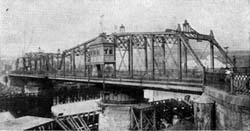 >
>